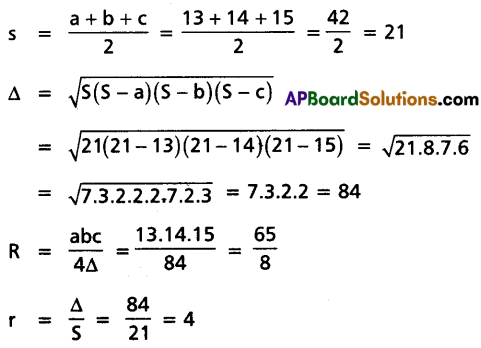Thoroughly analyzing AP Inter 1st Year Maths 1A Model Papers and AP Inter 1st Year Maths 1A Question Paper March 2019 helps students identify their strengths and weaknesses.
AP Inter 1st Year Maths 1A Question Paper March 2019
Time: 3 Hours
Maximum Marks: 75
Note: This question paper consists of three sections A, B, and C.
Section – A
(10 × 2 = 20 Marks)
I. Very Short Answer Type Questions.
- Answer all questions.
- Each question carries two marks.
Question 1.
If A = {-2, -1, 0, 1, 2} and f: A → B is a surjection defined by f(x) = x2 + x + 1, then find B.
Solution:
Given f(x) = x2 + x + 1
Since f: A → B is a surjection
∴ B = f(A)
⇒ B = {f(-2), f(-1), f(0), f(1), f(2)}
f(-2) = (-2)2 + (-2) + 1 = 4 – 2 + 1 = 3
f(-1)= (-1)2 + (-1) + 1 = 1 – 1 + 1 = 1
f(0) = 0 + 0 + 1 = 1
f(1) = 12 + 1 + 1 = 1 + 1 + 1 = 3
f(2) = 22 + 2 + 1 = 4 + 2 + 1 = 7
∴ B = {1, 3, 7}
Question 2.
If f(x) = 2x – 1, g(x) = \(\frac{x+1}{2}\) for all x ∈ IR, then find (gof) (x).
Solution:
Given f(x) = 2x – 1 and g (x) = \(\frac{x+1}{2}\)
(gof) (x) g = g[f(x)]
= g[2x – 1]
= \(\frac{2 x-1+1}{2}\)
= \(\frac{2x}{2}\)
= x
∴ (gof)(x) = x
![]()
Question 3.
If \(\left[\begin{array}{cc}
x-3 & 2 y-8 \\
z+2 & 6
\end{array}\right]=\left[\begin{array}{cc}
5 & 2 \\
-2 & a-4
\end{array}\right]\), then find the values of x, y, z and a.
Solution:
Given \(\left[\begin{array}{cc}
x-3 & 2 y-8 \\
z+2 & 6
\end{array}\right]=\left[\begin{array}{cc}
5 & 2 \\
-2 & a-4
\end{array}\right]\)
∴ x – 3 = 5 ⇒ x = 8
∴ 2y – 8 = 2 ⇒ 2y = 10 ⇒ y = 5
∴ z + 2 = -2 ⇒ z = -4
∴ 6 = a – 4 ⇒ a = 10
∴ x = 8, y = 5, z = -4 and a = 10.
Question 4.
Find the rank of this matrix \(\left[\begin{array}{lll}
1 & 2 & 3 \\
2 & 3 & 4 \\
0 & 1 & 2
\end{array}\right]\).
Solution:
Let A = \(\left[\begin{array}{lll}
1 & 2 & 3 \\
2 & 3 & 4 \\
0 & 1 & 2
\end{array}\right]\)
|A| = \(\left[\begin{array}{lll}
1 & 2 & 3 \\
2 & 3 & 4 \\
0 & 1 & 2
\end{array}\right]\)
= 1(6 – 4) – 2(4 – 0) + 3(2 – 0)
= 1(2) – 2(4) + 6
= 2 – 8 + 6
= 0
∴ The rank of A ≠ 3.
2-rowed minor of A = \(\left[\begin{array}{ll}
1 & 2 \\
2 & 3
\end{array}\right]\)
= 3 – 4
= -1 ≠ 0
∴ Rank of A = 2
Question 5.
Let \(\overline{\mathrm{a}}=2 \overline{\mathrm{i}}+4 \overline{\mathrm{j}}-5 \overline{\mathrm{k}}, \overline{\mathrm{b}}=\overline{\mathrm{i}}+\overline{\mathrm{j}}+\overline{\mathrm{k}}\) and \(\bar{c}=\bar{j}+2 \bar{k}\). Find the unit vector in the opposite direction of \(\bar{a}+\bar{b}+\bar{c}\).
Solution:
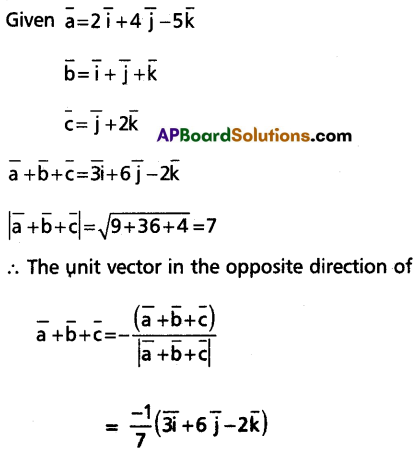
Question 6.
Find the Vector equation of the plane passing through the points \(\overline{\mathrm{i}}-2 \overline{\mathrm{j}}+5 \overline{\mathrm{k}},-5 \overline{\mathrm{j}}-\overline{\mathrm{k}}\) and \(-3 \overline{\mathrm{i}}+5 \overline{\mathrm{j}}\).
Solution:
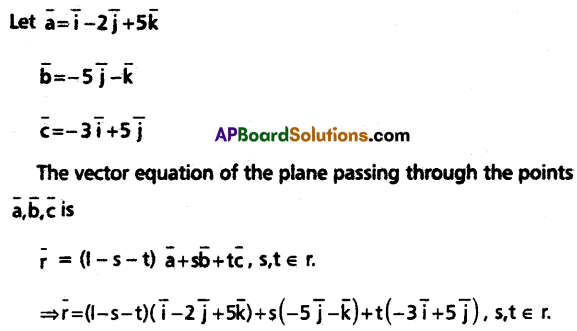
Question 7.
If the vectors \(\lambda \overline{\mathrm{i}}-3 \overline{\mathrm{j}}+5 \overline{\mathrm{k}}\) and \(2 \lambda \bar{i}-\lambda \bar{j}-\bar{k}\) are perpendicular to each other, find λ.
Solution:
Let \(\bar{a}=\lambda \bar{i}-3 \bar{j}+5 \bar{k}\)
\(\overline{\mathrm{b}}=2 \lambda \overline{\mathrm{i}}-\lambda \overline{\mathrm{j}}-\overline{\mathrm{k}}\)
Since \(\bar{a}\), \(\bar{b}\) are perpendicular to each other.
∴ \(\bar{a}. \bar{b}\) = 0
⇒ \((\lambda \overline{\mathrm{i}}-3 \overline{\mathrm{j}}+5 \overline{\mathrm{k}}) . \quad(2 \lambda \overline{\mathrm{i}}-\lambda \overline{\mathrm{j}}-\overline{\mathrm{k}})\) = 0
⇒ 2λ2 + 3λ – 5 = 0
⇒ 2λ2 + 5λ – 2λ – 5 = 0
⇒ λ(2λ + 5) – 1(2λ + 5) = 0
⇒ (λ – 1)(2λ + 5) = 0
⇒ λ – 1 = 0 (or) 2λ + 5 = 0
⇒ λ = 1 (or) 2λ = -5
⇒ λ = 1 (or) λ = \(\frac{-5}{2}\)
![]()
Question 8.
If sin θ = \(\frac{4}{5}\) and θ is not in the first quadrant, find the value of cos θ.
Solution:
Given sin θ = \(\frac{4}{5}\), θ is not in the first quadrant.
sin θ = \(\frac{4}{5}\)
∴ ‘θ’ lies in second quadrant.
cos2θ = 1 – sin2θ
= 1 – \(\frac{16}{5}\)
= \(\frac{9}{25}\)
cos θ = ±\(\frac{3}{5}\)
since θ lies in the second quadrant.
∴ cos θ = \(\frac{-3}{5}\)
Question 9.
If θ is not an integral multiple of \(\frac{\pi}{2}\), prove that tan θ + 2 tan 2θ + 4 tan 4θ + 8 cot 8θ = cot θ.
Solution:
we know cot θ – tan θ = 2 cot 2θ
⇒ cot θ – 2 cot 2θ = tan θ
L.H.S = tan θ + 2 tan 2θ + 4 tan 4θ + 8 cot 8θ
= (cot θ – 2 cot 2θ) + 2(cot 2θ – 2 cot 4θ) + 4(cot 4θ – 2 cot 8θ) + 8 cot 8θ
= cot θ – 2 cot 2θ + 2 cot 2θ – 4 cot 4θ + 4 cot 4θ – 8 cot 8θ + 8 cot 8θ
= cot θ
= R.H.S
∴ L.H.S = R.H.S
∴ tan θ + 2 tan 2θ + 4 tan 4θ + 8 cot 8θ = cot θ
Question 10.
Show that \(\tan h^{-1}\left(\frac{1}{2}\right)=\frac{1}{2} \log _e 3\).
Solution:
We know \({tan} h^{-1}(x)=\frac{1}{2} \log _e\left|\frac{1+x}{1-x}\right|\)
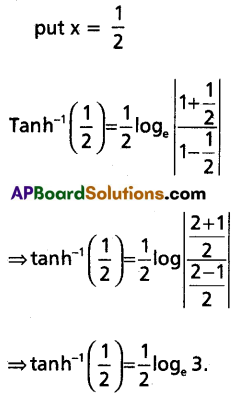
Section – B
(5 × 4 = 20 Marks)
II. Short Answer Type Questions.
- Answer any five questions.
- Each question carries four marks.
Question 11.
If A = \(\left[\begin{array}{rrr}
-1 & -2 & -3 \\
2 & 1 & -2 \\
2 & -2 & 1
\end{array}\right]\), then show that the adjoint of A is 3A’. Find A-1.
Solution:
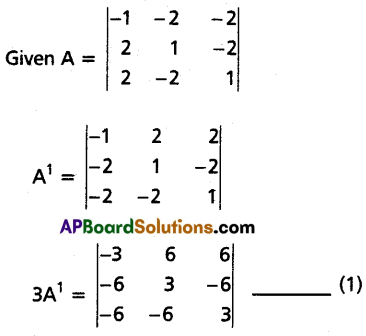

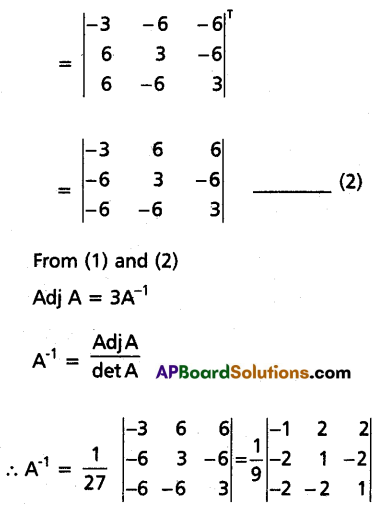
Question 12.
Show that the line joining the pair of points \(6 \bar{a}-4 \bar{b}+4 \bar{c},-4 \bar{c}\) and the line joining the pair of points \(-\bar{a}-2 \bar{b}-3 \bar{c}, \bar{a}+2 \bar{b}-5 \bar{c}\), intersect at the point -4\(\bar{c}\), when \(\bar{a}, \bar{b}, \bar{c}\) is non-coplanar vectors.
Solution:
The vector equation or the line joining the pair of points

If (1) and (2) intersect then
6 – 6t = -1 + 2s ⇒ 6t + 2s – 7 = 0 …………(3)
-4 + 4t = -2 + 4s ⇒ 4t + 4s – 2 = 0 ………(4)
4 – 8t = -3 – 2s ⇒ 8t – 2s – 7 = 0 ………..(5)
(3) + (5) ⇒ 14t – 14 = 0
⇒ t – 1 = 0
⇒ t = 1
From (3),
6 + 2s – 7 = 0
⇒ 2s – 1 = 0
⇒ s = \(\frac{1}{2}\)
from (4),
4(1) – 4(\(\frac{1}{2}\)) – 2 = 4 – 2 – 2 = 0
t = 1, s = \(\frac{1}{2}\) satisfies (2).
∴ Point is intersection \(\bar{r}=(6-6) \bar{a}+(-4+4) \bar{b}+(4-8) \bar{c}\)
⇒ \(\bar{r}=-4 \bar{c}\)
![]()
Question 13.
If \(\bar{a}=2 \bar{i}+\bar{j}-\bar{k}, \bar{b}=-\bar{i}+2 \bar{j}-4 \bar{k}\) and \(\bar{c}=\bar{i}+\bar{j}+\bar{k}\), then find \((\overline{\mathrm{a}} \times \overline{\mathrm{b}}) \cdot(\overline{\mathrm{b}} \times \overline{\mathrm{c}})\).
Solution:
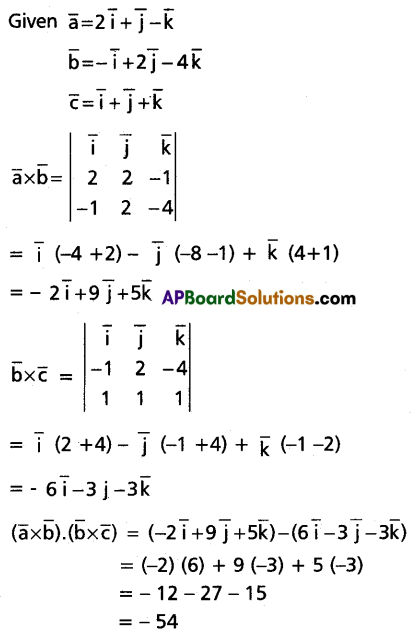
Question 14.
Prove that \(\left(1+\cos \frac{\pi}{10}\right)\left(1+\cos \frac{3 \pi}{10}\right)\left(1+\cos \frac{7 \pi}{10}\right)\left(1+\cos \frac{9 \pi}{10}\right)=\frac{1}{16}\).
Solution:
L.H.S = \(\left(1+\cos \frac{\pi}{10}\right)\left(1+\cos \frac{3 \pi}{10}\right)\left(1+\cos \frac{7 \pi}{10}\right)\left(1+\cos \frac{9 \pi}{10}\right)\)

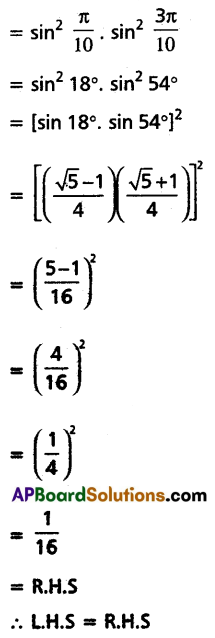
∴ \(\left(1+\cos \frac{\pi}{10}\right)\left(1+\cos \frac{3 \pi}{10}\right)\left(1+\cos \frac{7 \pi}{10}\right)\left(1+\cos \frac{9 \pi}{10}\right)=\frac{1}{16}\)
Question 15.
Give p ≠ ±q, show that the solutions of cos pθ + cos qθ = 0 forms two series each of which is in A.P. Also, find the common difference between each A.P.
Solution:

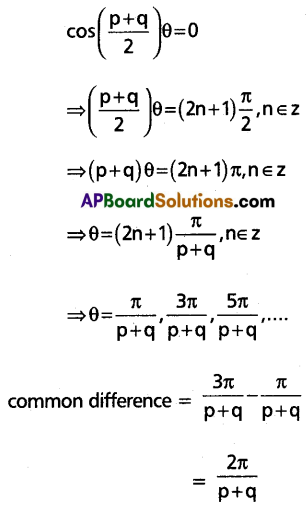
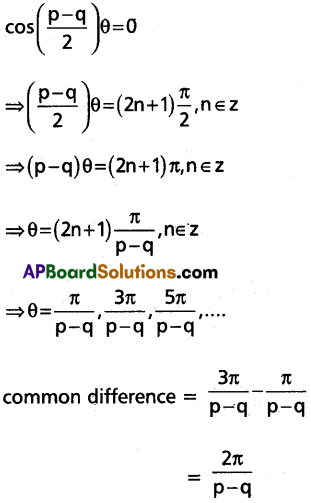
Question 16.
Prove that \(\tan ^{-1} \frac{1}{2}+\tan ^{-1} \frac{1}{5}+\tan ^{-1} \frac{1}{8}=\frac{\pi}{4}\).
Solution:
L.H.S = \(\tan ^{-1}\left(\frac{1}{2}\right)+\tan ^{-1}\left(\frac{1}{5}\right)+\tan ^{-1}\left(\frac{1}{8}\right)\)

Question 17.
In ΔABC if a = (b + c) cos θ, then prove that sin θ = \(\frac{2 \sqrt{b c}}{b+c} \cos \frac{A}{2}\).
Solution:


Section – C
(5 × 7 = 35 Marks)
III. Long Answer Type Questions.
- Answer any five questions.
- Each question carries seven marks.
Question 18.
Let f: A → B, g : B → C be bijections, then prove that, (gof)-1 = f-1og-1.
Solution:
f: A → B, g: B → C are bijections
⇒ gof: A → C is a bijection
Also g-1: C → B and f-1: B → A are bijections
⇒ f-1og-1: C → A is a bijection
Let c be any element of C.
Then ∃ an element b ∈ B such that g(b) = c
⇒ b = g-1(C)
Also ∃ an element a ∈ A such that f(a) = b
⇒ a = f-1(b)
Now (gof) (a) = g(f(a) = g(b) = c
⇒ a = (gof)-1 (c)
⇒ (gof)-1(c) = a
Also (f-1 o g-1) (c) = f-1(g-1(c)) = f-1(b) = a
∴ From (1) and (2);
(gof)-1 (c) = (f-1 o g-1 (c))
⇒ (gof)-1 = f-1 o g-1
![]()
Question 19.
Using mathematical induction, prove that for all n ∈ N.
a + ar + ar2 + …… up to n terms = \(\frac{a\left(r^n-1\right)}{(r-1)}\), r ≠ 1.
Solution:
the nth term of the given series is arn-1.
Let p(n) be the statement that
a + ar + ar2 + ….. + arn-1 = \(\frac{a\left(r^n-1\right)}{r-1}\), r ≠ 1
When n = 1
Then L.H.S = a
R.H.S = \(\frac{a(r-1)}{r-1}\) = a
∴ L.H.S = R.H.S
∴ P(1) is true.
Assume that p(k) is true
a + ar + ar2 + ….. + ark-1 = \(\frac{a\left(r^k-1\right)}{r-1}\)
adding ark on both sides
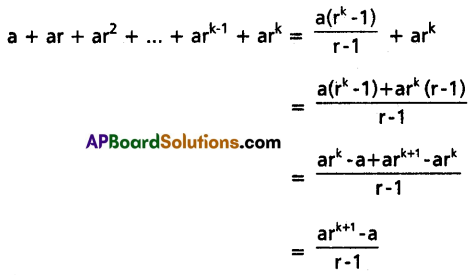
= \(\frac{a\left(r^{k+1}-1\right)}{r-1}\)
∴ p(k + 1) is true.
By the Principle of finite mathematical induction p(n) is true for all x ∈ n.
∴ a + ar + ar2 + …… up to n terms = \(\frac{a\left(r^n-1\right)}{(r-1)}\), r ≠ 1
Question 20.
Show that \(\left|\begin{array}{lll}
a & b & c \\
b & c & a \\
c & a & b
\end{array}\right|^2\) = \(\left|\begin{array}{ccc}
2 b c-a^2 & c^2 & b^2 \\
c^2 & 2 a c-b^2 & a^2 \\
b^2 & a^2 & 2 a b-c^2
\end{array}\right|\) = (a3 + b3 + c3 – 3abc)2.
Solution:


Question 21.
x – y + 3z = 5, 4x + 2y – z = 0, -x + 3y + z = 5, solve the system of equations by using Cramer’s rule.
Solution:
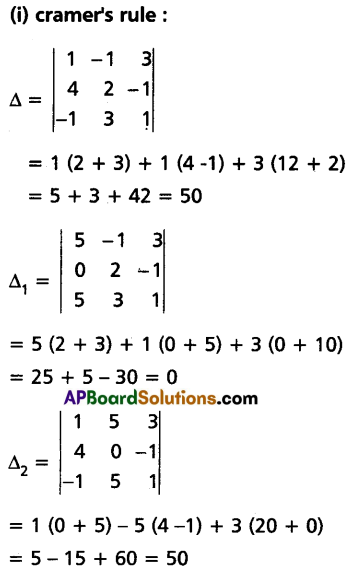
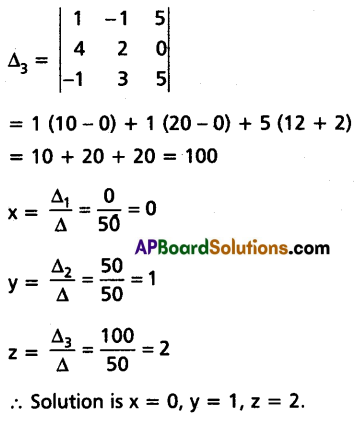
Question 22.
Show that the volume of a tetrahedron with \(\bar{a}\), \(\bar{b}\) and \(\bar{c}\) as coterminous edges is \(\frac{1}{6}\left[\begin{array}{lll}
\bar{a} & \bar{b} & \bar{c}
\end{array}\right]\).
Solution:
Let OABC be a tetrahedron
\(\overline{\mathrm{OA}}=\overline{\mathrm{a}}\)
\(\overline{\mathrm{OB}}=\overline{\mathrm{b}}\)
\(\overline{\mathrm{OC}}=\overline{\mathrm{c}}\)
Let v be the volume or the tetrahedron OABC.
By definition
V = \(\frac{1}{3}\) (area of the base ΔOAB) (length of the perpendicular from C to the base ΔOAB)
= \(\frac{1}{3}\) (area of the base ΔOAB) (CN)
\(\overline{\mathrm{OM}}\) = perpendicular to the both vectors \(\bar{a}\), \(\bar{b}\)
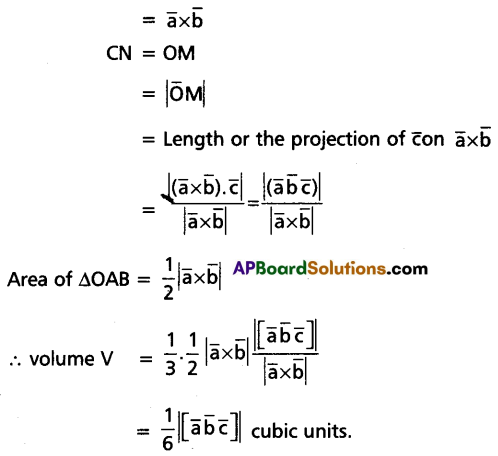
Question 23.
If A + B + C = 0, prove that sin 2A + sin 2B + sin 2C = -4 sin A sin B sin C.
Solution:
Given A + B + C = 0°
L.H.S = sin 2A + sin 2B + sin 2C
= 2 sin\(\left(\frac{2 A+2 B}{2}\right)\) cos\(\left(\frac{2 A-2 B}{2}\right)\) + 2 sin C cos C
= 2 sin (A + B) cos (A – B) + 2 sin C cos C
= 2 sin (-C) cos (A – B) + 2 sin C cos (-A – B)
= -2 sin C cos (A – B) + 2 sin C cos (A + B)
= -2 sin C [cos (A – B) – cos (A + B)]
= -2 sin C [2 sin A sin B]
= -4 sin A sin B sin C
= R.H.S
∴ L.H.S = R.H.S
∴ sin 2A + sin 2B + sin 2C = -4 sin A sin B sin C
![]()
Question 24.
In a ΔABC, if a = 13, b = 14, c = 15, show that R = \(\frac{65}{8}\), r = 4, r1 = \(\frac{21}{2}\), r2 = 12 and r3 = 14.
Solution:
Given a = 13, b = 14, c = 15
